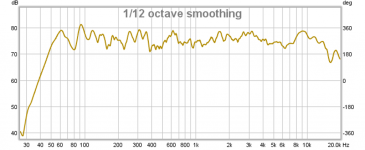Tux,
I love my miniDSP - they are very slick and I can't imagine going back to passive crossovers. The ability to reconfigure on the fly or to test out 1st, 2nd, 4th order filters is amazingly easy. I am with you, I think I will need a second one.
I got lucky with that woofer as I picked it mostly for price but liked it for the high Qts, the 88dB sensitivity, the 3.5mm xmax, and the 4 ohms. It appears to be the same driver Dayton uses in their B652 bookshelf speakers. Regarding transient response of a smaller woofer vs a bigger one: certainly the lighter mass of the cone will allow the smaller driver to accelerate faster on a step response. Even though the XO is at 300 Hz, that is not saying that the fastest rise time is 3.33 ms. The rise time is dictated by the motor strength (Bl), the cone mass, and the suspension stiffness and damping. Even with a 30 Hz low pass, a cone can still have sub ms rise times if it is light. For woofers with really heavy cones their fs may be low but that comes at the expense of possible phase delay between the drive voltage and the actual woofer response. I think this is why tweeters are sometimes given delays for time alignment with woofer even on a flat baffle. Sometimes done by leaning baffle backwards?
I don't have a 15 in woofer to test against but I think transients will sound more authentic and crisp with a bunch of smaller drivers as long as they push similar displacements. I also think that spreading the work over smaller woofers also reduces distortion.
I plan on aligning the 6 drivers vertically just like the picture in the Nelson Pass article. It would be even better to put the basket of one side in the slot and wire out of phase so that motor nonlinearities are cancelled out.
I love my miniDSP - they are very slick and I can't imagine going back to passive crossovers. The ability to reconfigure on the fly or to test out 1st, 2nd, 4th order filters is amazingly easy. I am with you, I think I will need a second one.
I got lucky with that woofer as I picked it mostly for price but liked it for the high Qts, the 88dB sensitivity, the 3.5mm xmax, and the 4 ohms. It appears to be the same driver Dayton uses in their B652 bookshelf speakers. Regarding transient response of a smaller woofer vs a bigger one: certainly the lighter mass of the cone will allow the smaller driver to accelerate faster on a step response. Even though the XO is at 300 Hz, that is not saying that the fastest rise time is 3.33 ms. The rise time is dictated by the motor strength (Bl), the cone mass, and the suspension stiffness and damping. Even with a 30 Hz low pass, a cone can still have sub ms rise times if it is light. For woofers with really heavy cones their fs may be low but that comes at the expense of possible phase delay between the drive voltage and the actual woofer response. I think this is why tweeters are sometimes given delays for time alignment with woofer even on a flat baffle. Sometimes done by leaning baffle backwards?
I don't have a 15 in woofer to test against but I think transients will sound more authentic and crisp with a bunch of smaller drivers as long as they push similar displacements. I also think that spreading the work over smaller woofers also reduces distortion.
I plan on aligning the 6 drivers vertically just like the picture in the Nelson Pass article. It would be even better to put the basket of one side in the slot and wire out of phase so that motor nonlinearities are cancelled out.
What you're describing is different from impulse response. And there are all kinds of opinions on woofer speed 
This is because the acoustic center of the woofer is physically further back than the tweeter's acoustic center. Not because the tweeter is faster.
I think this is why tweeters are sometimes given delays for time alignment with woofer even on a flat baffle. Sometimes done by leaning baffle backwards?
This is because the acoustic center of the woofer is physically further back than the tweeter's acoustic center. Not because the tweeter is faster.
I took my own advice and reconfigured the XO at 210 Hz to avoid having to EQ out the bump at 270 Hz. It worked! Here is the in-room response at listening position with some miniDSP REW magic applied. You will have to interpolate the 5dB grid with your eyes as it is 10dB. My mini netbook screen is too small and at 5dB the image gets clipped. Anyhow, this speaker sounds quite nice - only had a chance to test out some vocals and jazz so far but liked what I hear.
Attachments
I'm not sure I'm understanding what you're saying. Are you saying, the impulse response is a measurement of the rise time of the cone? Or is STEP reponse the rise time of the cone? Or they're the same?
Here are three tweeter measurements I made:
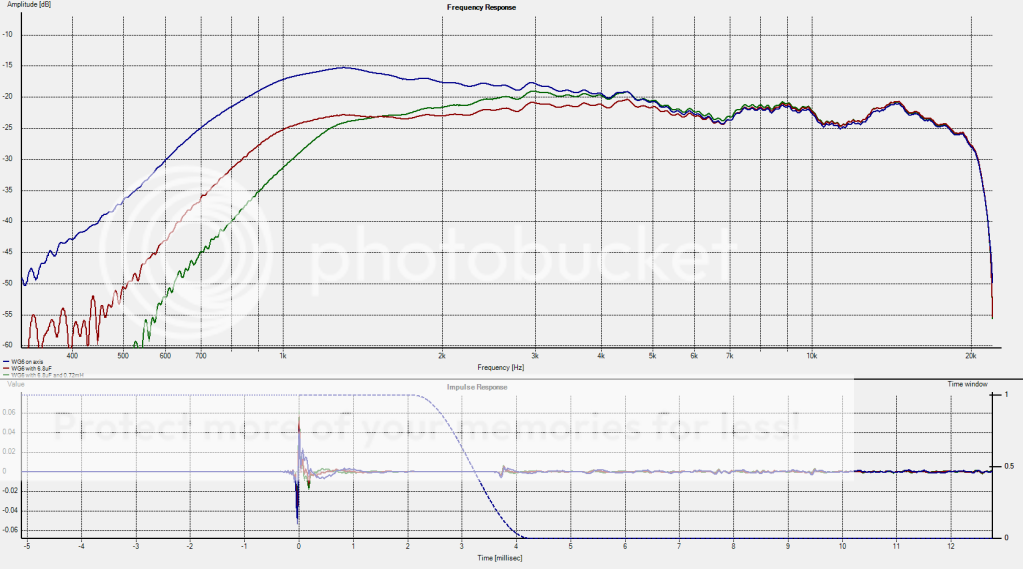
Can you tell me which one is the fastest? Sorry, the IR window is fairly small.
Here are three tweeter measurements I made:

Can you tell me which one is the fastest? Sorry, the IR window is fairly small.
They are related. A driver/speaker with poor (non-smooth) frequency response will not be able to produce a good IR - as it shows up as a smaller bandwidth and bumpy or irregular FR plot. Every little bump in a FR (freq domain) shows up as a ripple in the IR (time domain) through the inverse FFT. The close to ideal FR is flat plateau with gently sloping low freq roll off, and gently sloping high freq roll off. The only perfect FR is an infinitely wide bandwidth FR to produce an infinitely narrow IR. Smooth and wide FR give clean and tight IR. Based on this I would say that red FR from your tweeter will give best IR as it is the best compromise of wide and smooth (flat and not leaning) - but it is so close to the green that it is a wash.
So then you agree that IR has nothing to do with speed? So the smaller woofers won't necessarily provide a better IR, perhaps the larger one will because it'll give a wider bandwidth.
BTW, they're all three the same tweeter with different high pass filters applied. So all the same "speed".
BTW, they're all three the same tweeter with different high pass filters applied. So all the same "speed".
I think there may be a difference in terms we are using. "Speed" is a silly term to use to describe driver performance. I am saying a low mass cone will accelerate faster than a heavier cone (F=ma). This affects the rise time of a pressure pulse that can be generated. A filter or cross over changes the range of freq that the driver can act, but its native ability to accelerate given a step voltage function is a function of its mass and motor strength. For two drivers with the same motor and suspension, the lower mass cone will produce a pressure pulse with a faster rise time.
I know that you used the same tweeter and within the ability of the inverse FFT to recreate the time domain from the measured frequency domain - you see that the IR is all about the same. Look at the rise time - it is the same - the decay is affected by the filters you add.
If you want to argue that a 15 in woofer has the same impulse rise time in the time domain as a 3 in full range or tweeter, you should use that as tweeter.
I know that you used the same tweeter and within the ability of the inverse FFT to recreate the time domain from the measured frequency domain - you see that the IR is all about the same. Look at the rise time - it is the same - the decay is affected by the filters you add.
If you want to argue that a 15 in woofer has the same impulse rise time in the time domain as a 3 in full range or tweeter, you should use that as tweeter.
Last edited:
I mounted the TC9FD18 in two open test baffles and compared the polar response from 0.5-5 kHz:
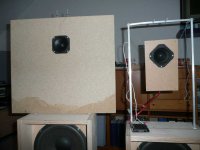
Left baffle is 50x45 cm, right baffle is 14x21 cm.
This is the 0-90° response of the large baffle:
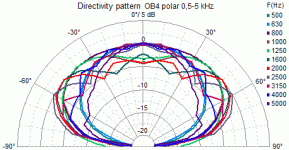
And this for the small baffle:
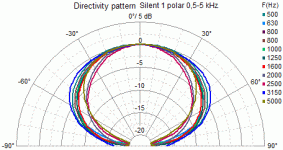
I choose 0.5-5 kHz because that's where the imaging happens according to Toole.
Just to make you guys aware that there is more than the 0° response .
.
If I normalise the large baffle response to constant spl at 0° too, it looks like this :
:
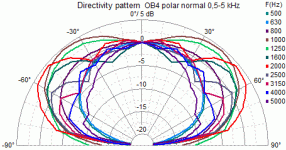
Rudolf

Left baffle is 50x45 cm, right baffle is 14x21 cm.
This is the 0-90° response of the large baffle:

And this for the small baffle:

I choose 0.5-5 kHz because that's where the imaging happens according to Toole.
Just to make you guys aware that there is more than the 0° response
If I normalise the large baffle response to constant spl at 0° too, it looks like this

Rudolf
I see why narrow baffles image well. Do you get any response below 500 Hz though? I want to xo at 200 Hz.
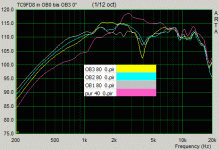
OB1 is 40x14 cm (HxW), OB2 is 21x14cm, OB3 is 14x14 cm. "pur" is without any baffle. I voted for best imaging with OB2. It does barely work down to 500 Hz. I'm not sure if the 50x45 cm baffle reaches 200 Hz.
Each of us has to choose the compromise that works best for him. I just wanted to show that it's always a compromise and no "optimum".
There you are:Wonder what it would look like without any baffle at all...
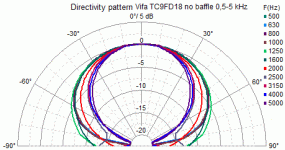
It seems that a small baffle can be helpful at times.
Rudolf
The Manzanita is the "American way" imho. If SPL is your first concern, you have to go that route. It has to sound "full bodied" with a wide sweet spot, which for many will be more desirable than the lean but focused, more precise imaging of the narrow baffle.Makes you wonder about the Manzanita with the 15" and the wide baffle used...
Very nice research! Makes you wonder about the Manzanita with the 15" and the wide baffle used...
X, can you squeeze out higher output out of those 6" drivers? Maybe you need to go 3 way.
I plan to get more output by going with qnty 6 of the 6.5 in drivers arranged in a slot baffle (3 high x 2 push-push drivers). This should get about 5dB for drivers alone, slot loading adds another +2dB according to Mr Pass. Although that boost depends on baffle width and slot dimensions. I will play with that in the sims. I am starting to narrow down to a 21 in tall x 1.75 in wide x 10 in deep slot with 6 drivers pumping pressure into it. I will have to see how high the baffle can go to XO higher with the Vifa and have a narrower baffle for improved imaging. I see some OB studio monitors with a narrow baffle around the tweeter. This is probably why.
xrk971, you seem to be talking in circles. You said the smaller drivers will have a better IR, then you said a better IR is based on frequency extension, and you keep bring weight of cone into the discussion. I'm just trying to understand why you think the smaller woofers will have better IR in a 2-way like this where the Vifa driver is absolutely going to dominate the IR because it dominates the FR.
Consider what Joseph D'Appolito has to say on the subject:
"Let's now turn to the time domain for additional performance insight. We could examine the impulse response in more detail, but it is not easily interpreted. It is dominated by the tweeter response [or in this case, the Vifa driver] in the first few milliseconds. It doesn't tell us much about the woofer, or the midrange if there is one, because all the low-frequency information is in the impulse response tail, which is at a very low signal level."
Didn't I mention the information in the IR related to the woofer would be in the 3+ millisecond range?
What I'm trying to say is: Don't pick your woofer based on an Impulse Response. That's a bad was to decide.
Consider what Joseph D'Appolito has to say on the subject:
"Let's now turn to the time domain for additional performance insight. We could examine the impulse response in more detail, but it is not easily interpreted. It is dominated by the tweeter response [or in this case, the Vifa driver] in the first few milliseconds. It doesn't tell us much about the woofer, or the midrange if there is one, because all the low-frequency information is in the impulse response tail, which is at a very low signal level."
Didn't I mention the information in the IR related to the woofer would be in the 3+ millisecond range?
What I'm trying to say is: Don't pick your woofer based on an Impulse Response. That's a bad was to decide.
Rudolf,
Thanks for sharing those circle polars. I don't have direct experience measuring OB speakers, but based on information from people like you and others, it seems most OB enthusiasts always choose as narrow of baffle as possible. This dipole peak off axis issue is always the basis for that decision.
Thanks for sharing those circle polars. I don't have direct experience measuring OB speakers, but based on information from people like you and others, it seems most OB enthusiasts always choose as narrow of baffle as possible. This dipole peak off axis issue is always the basis for that decision.
Tux,
I appreciate your feedback on IR and how it is in 3 ms range for woofers. This doesn't match my observations from measurement of this 6.5 inch driver in the Nautaloss sub cabinet (which behaves much like an OB in sense that back wave is not reflected back to cone). I have sub millisecond impulse response and the rise time I see here is the inherent ability of this driver to respond to a step change function.
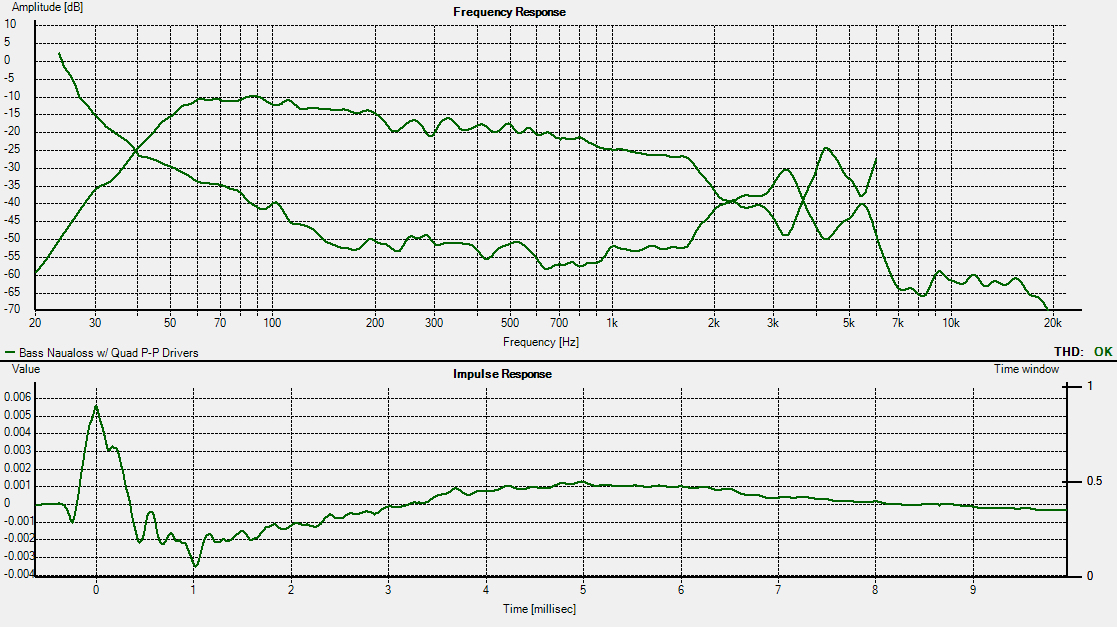
This is a double driver push-pull but that just removes ringing - rise time is about the same.
I appreciate your feedback on IR and how it is in 3 ms range for woofers. This doesn't match my observations from measurement of this 6.5 inch driver in the Nautaloss sub cabinet (which behaves much like an OB in sense that back wave is not reflected back to cone). I have sub millisecond impulse response and the rise time I see here is the inherent ability of this driver to respond to a step change function.

This is a double driver push-pull but that just removes ringing - rise time is about the same.
Now low pass it and add the Vifa. Then measure just the Vifa. The Vifa will dominate. That's what I'm saying. Yes, all woofers produce an impulse response, I certainly wouldn't deny that. But saying one woofer's IR is better than the other and making a decision based on that seems pointless if you're going to low pass it and add a mid tweeter.
FWIW, I would pick the multiple smaller woofers as well. I already said that. But not based on IR.
BTW, that measurement looks like a nearfield? And is full bandwidth woofer only (ie. no filter applied)? Why did you stop the sweep at 6khz?
FWIW, I would pick the multiple smaller woofers as well. I already said that. But not based on IR.
BTW, that measurement looks like a nearfield? And is full bandwidth woofer only (ie. no filter applied)? Why did you stop the sweep at 6khz?
- Home
- Loudspeakers
- Full Range
- Cheap and FAST OB, Literally
